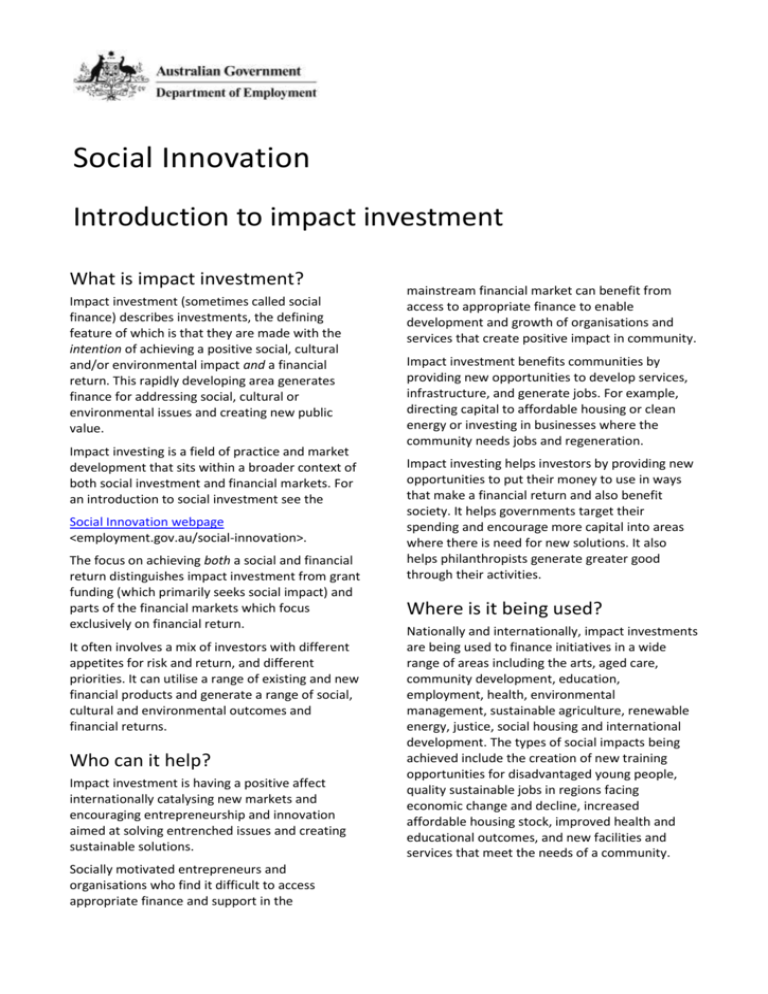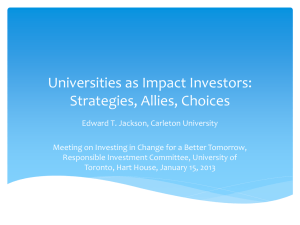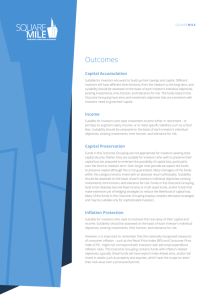DOCX file of Introduction to impact investment
advertisement

Social Innovation Introduction to impact investment What is impact investment? Impact investment (sometimes called social finance) describes investments, the defining feature of which is that they are made with the intention of achieving a positive social, cultural and/or environmental impact and a financial return. This rapidly developing area generates finance for addressing social, cultural or environmental issues and creating new public value. Impact investing is a field of practice and market development that sits within a broader context of both social investment and financial markets. For an introduction to social investment see the Social Innovation webpage <employment.gov.au/social-innovation>. The focus on achieving both a social and financial return distinguishes impact investment from grant funding (which primarily seeks social impact) and parts of the financial markets which focus exclusively on financial return. It often involves a mix of investors with different appetites for risk and return, and different priorities. It can utilise a range of existing and new financial products and generate a range of social, cultural and environmental outcomes and financial returns. Who can it help? Impact investment is having a positive affect internationally catalysing new markets and encouraging entrepreneurship and innovation aimed at solving entrenched issues and creating sustainable solutions. Socially motivated entrepreneurs and organisations who find it difficult to access appropriate finance and support in the mainstream financial market can benefit from access to appropriate finance to enable development and growth of organisations and services that create positive impact in community. Impact investment benefits communities by providing new opportunities to develop services, infrastructure, and generate jobs. For example, directing capital to affordable housing or clean energy or investing in businesses where the community needs jobs and regeneration. Impact investing helps investors by providing new opportunities to put their money to use in ways that make a financial return and also benefit society. It helps governments target their spending and encourage more capital into areas where there is need for new solutions. It also helps philanthropists generate greater good through their activities. Where is it being used? Nationally and internationally, impact investments are being used to finance initiatives in a wide range of areas including the arts, aged care, community development, education, employment, health, environmental management, sustainable agriculture, renewable energy, justice, social housing and international development. The types of social impacts being achieved include the creation of new training opportunities for disadvantaged young people, quality sustainable jobs in regions facing economic change and decline, increased affordable housing stock, improved health and educational outcomes, and new facilities and services that meet the needs of a community. Who are impact investors? Impact investors are the people or organisations that provide the capital for impact investments. They include governments, philanthropists, private investors, corporations and institutional investors (such as superannuation funds). A range of factors influence the approach of any given impact investor. These include: their motivations for investing, the types of investments they can make within their organisational and capital structure, their appetite for risk and their expectations with regard to social outcomes and financial returns. How does it work? Impact investments track many of the existing asset classes in financial markets, including cash, fixed interest, infrastructure and alternative assets. The investment opportunity can mirror existing financial products available in debt and equity markets or involve innovations that respond to structural barriers or new opportunities. There is also a growing interest in the use of new ‘hybrid’ mechanisms by government and philanthropy. For example, social impact bonds, which are not ‘bonds’ in the traditional sense, are a unique approach to contracting and financing across sectors to achieve and encourage better outcomes in a particular area of social need. Impact investments can be flexible. They can also take time to design and negotiate, and may not be suitable in all circumstances. One investment: Many investors: different rates of return Impact investments may involve one investor providing finance directly to an entrepreneur or organisation. They can also involve a mix of investors coming together in a single investment, or putting the capital into an investment fund to finance a wider range of projects. Not all investors want or need the same type or rate of financial return from an investment. Not all investors may have the same appetite or capacity to take on risk. The advantage of having different types of investors involved in the one deal is that it can help spread the financial risk. This creates new opportunities for collaboration because creative utilisation of even (relatively) small amounts of capital that can assume greater risk (such as government or philanthropic capital) can attract even more capital to the particular issue. This is sometimes referred to as ‘but for’ capital in the sense that it has enabled a much greater level of investment to have an impact on the particular social issue, that ‘but for’ the risk capital would not have been possible. International experience is showing that impact investment does not need to be a ‘trade-off’ between social and financial return. An Australian example The Social Enterprise Development and Investment Funds (SEDIF) is an initiative designed to improve access to capital for social enterprises, and in the longer-term, catalyse the broader social investment market in Australia. Grant funding of $20 million has been more than matched by other investors in three new funds to create a total investment pool of more than $40 million. The three SEDIF fund managers are using the pooled capital to provide tailored financial products, primarily loans, to social enterprises to help them purchase premises and equipment, develop new services, or expand existing services for the benefit of their communities. Further reading For more information and examples of impact investing in Australia, visit the Social Innovation webpage <employment.gov.au/impact-investing> For an overview of the Australia impact investing landscape see IMPACT—Australia: Investment for social and economic benefit











